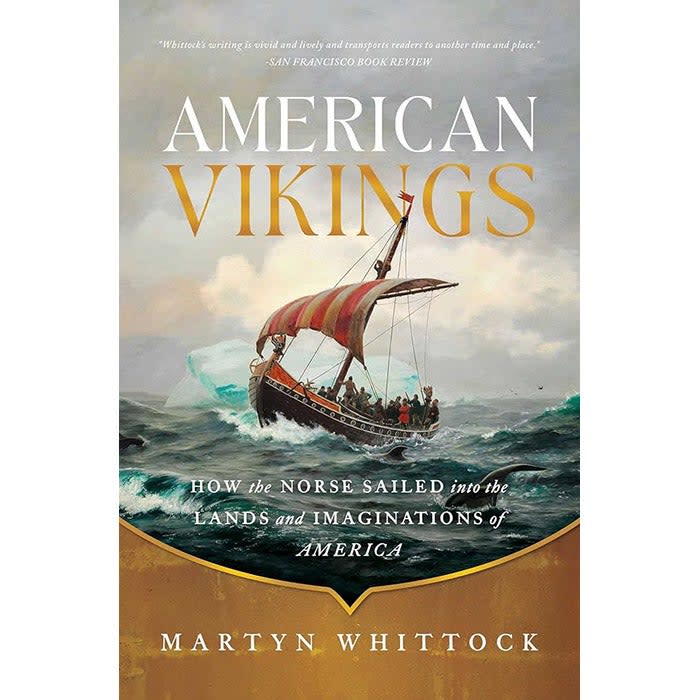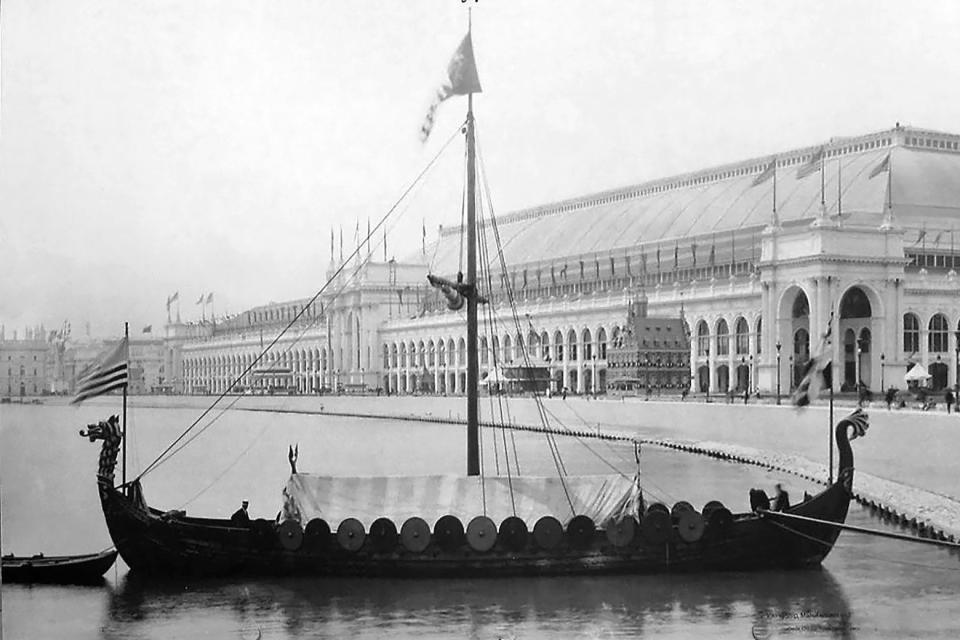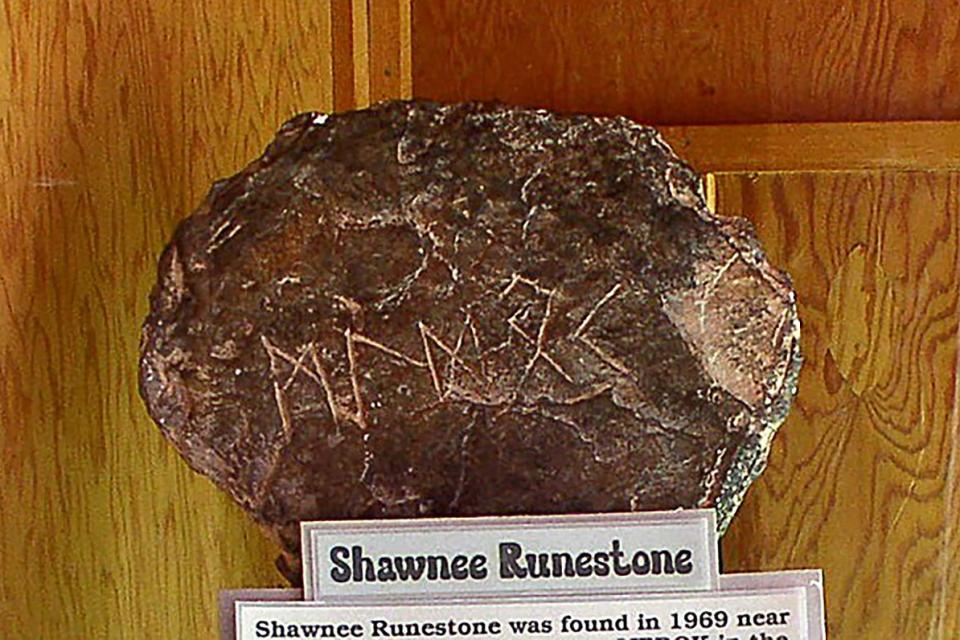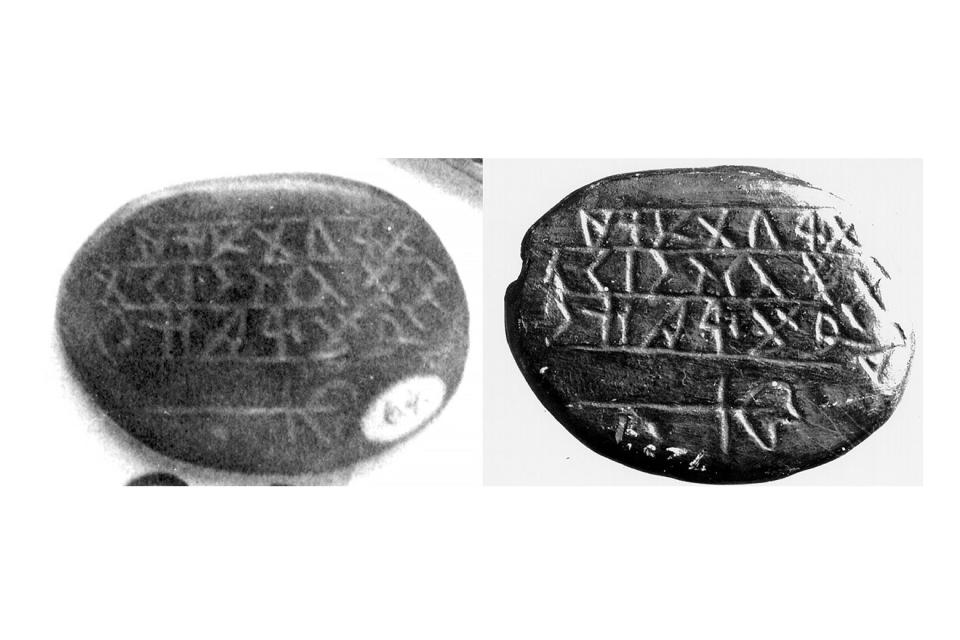Why Americans Simply Love to Forge Viking Artifacts
There are a variety of clues which may suggest that Vikings penetrated further south and west into North America than (as has been confirmed) Newfoundland. Some of these are faint possibilities, such as an expedition which may have lain behind the Kensington Runestone, which was discovered in Minnesota in 1898. While highly skeptical regarding this artifact, we may keep open to the very slight possibility of its authenticity. This is even more true regarding the Yarmouth Stone and the Narragansett Runestone, discovered in Nova Scotia and Rhode Island in 1812 and 1984, respectively. Their locations make them more likely to be authentic than Kensington, although they are not without their problems, some of which are serious. When it comes to the Maine Penny, said to have been discovered in Maine in 1957, we are on much surer ground, even if its routeway to its eventual find-spot was probably via Native American trade networks rather than any direct Norse presence at the site.
But there are also many cases of clear forgeries and hoaxes—or, possibly, Native American monuments which have been culturally hijacked in the search for evidence of Vikings. They mark an acceleration point in the history of the search for American Vikings which takes us beyond a search for historic penetration of the continent and instead reveals penetration of the minds and imaginations of later Americans. This was prompted by three main factors.
The first was increasing awareness of the saga claims (based on medieval Icelandic stories mixing traditions and legends) regarding exploration of North America—awareness which accelerated during the 19th century and continued through the 20th century to today. While there had been knowledge of them in Scandinavia and Iceland for centuries, this increased in North America after 1800 and particularly after 1850. Heightened awareness led to a search for corroborative evidence which was connected to the events narrated in the sagas.

The second was the increasing presence of Scandinavian pioneers and settlers in the western expansion of the United States in the 19th century. Some pioneers sought validation of their ownership of the newly taken land through references to ancient saga claims. By no means were all of these Scandinavian, but latter-day Norse played a major part in this process. For the most skeptical 21st-century commentators, the Kensington Runestone is an example of this process at work in the Midwest in the second half of the 19th century.
The third factor was the urge to assert European prior claim to land, which predated the Columbus expedition of 1492, and furthermore, gave it a northern European character. At times, this involved the expropriation of Native American monuments as part of a process which sought to belittle Native American cultural and monumental achievements by claiming Viking ancestry for them—and at times, claimed that those responsible were just about anybody, so long as they were not Native Americans.
Between 1820 and 1920, over 2.1 million Scandinavians emigrated to America. Just over half were Swedish, almost a third were Norwegian, and one-seventh were Danish. About 125,000 Scandinavians came to the U.S. before the start of the Civil War in 1861, but most arrived between the end of that war in 1865 and the outbreak of World War I in 1914.
Many came because they saw opportunities for personal advancement in the U.S. as the western frontier opened, even though Scandinavia saw significant industrialization and economic growth in this period (1865–1914). Several political and economic factors combined to encourage emigration. Some young Finns left Finland, which was then part of the Russian Empire, to avoid tsarist conscription. Denmark was defeated in war with Prussia in 1864 and lost territory to the unifying German state; consequently, some young Danes living in what is now southern Denmark wanted to avoid conscription into the kaiser’s army of the German Empire. Problems in agriculture, official corruption, restrictive and powerful state churches, and the increasing gulf between rich and poor encouraged many thousands of Scandinavians to seek what they believed would be a better life in the U.S. Letters sent back home by pioneering family members, which extolled the opportunities and the wide-open spaces, were sometimes accompanied by prepaid shipping tickets, and spurred family members to emigrate and join those already in North America.
Most Scandinavians eventually settled in rural areas of the Midwest and the Great Plains, especially in Illinois, Iowa, Minnesota, North Dakota, and Wisconsin. Before the 1870s, few Scandinavians settled on the West Coast, with just 65 Norwegians reported in Washington Territory in 1870, and 47 in Oregon. This changed after the 1880s, as railroad construction made it easier to reach the Pacific Northwest, where the topography was reminiscent of lands back home; about 150,000 Scandinavians settled in the Pacific Northwest region between 1890 and 1910.
However, this did not diminish the Scandinavian character that had developed in the Midwest. This explains several “Viking finds” that were later made there. The first Swedes on the U.S. Census in the Minnesota Territory were recorded in 1850, and it would be one of the Minnesota Swedes who would later discover the Kensington Runestone in 1898. Norwegian man Kleng Pedersen Hesthammer (also known as Cleng Peerson) made two trips to the U.S. in 1821 and 1825; he moved through the Midwest and eventually settled in Texas, where his gravestone reads: “Cleng Peerson, the first Norwegian Emigrant to America.” The evidence from the sagas undermines this bold claim. There had been Norwegians (by way of Iceland and Greenland) who had made it to America by the 1020s at the latest. In addition to this saga evidence, the many supposed North American runestones would insist that he was not the first to arrive.
Together, these Scandinavian settlers made a distinctive contribution to the development of the cultural character of the United States. They also had a sizeable impact on the search for American Vikings, as can be seen in the discovery of the Kensington Runestone and then the discovery of other clues believed to be artifacts left behind by medieval Norse explorers and settlers in the Midwest.
The new Norse arrivals had a strong incentive to seek legitimacy in their new homes. Scandinavian farmers—struggling to make a living in Minnesota, Wisconsin, and the Dakota Territory—were often regarded with condescension by the New England cultural elites who appeared to dominate society in the northern part of the expanding nation. For the latter, it was the Mayflower settlement from 1620 onward which had laid the foundations for what became the United States. It was very much a Yankee origin myth, and one that appeared to gain even greater legitimacy following the northern victory in the bitterly contested Civil War. However, this had unexpected consequences in the pushback it prompted. The increased Scandinavian presence in the U.S. encouraged (both consciously and unconsciously) these Norse newcomers to promote an alternative origin myth, one that long predated the arrival of the Mayflower off Cape Cod in 1620. Theirs would stimulate a search for Viking roots to substantiate the saga claims and would go far beyond what these early written sources claimed in terms of geographical reach.

In 1893 the World’s Columbian Exposition, held in Chicago, celebrated the 400th anniversary of the first voyage of Columbus. The new Swedish and Norwegian communities, aware of the saga evidence, found this celebration rather provocative. In fact, the matter was discussed in many newspaper articles read by Norwegians and Swedes, in the U.S. and in Scandinavia. In this context, money was raised on both sides of the Atlantic to pay for the construction of a full-sized replica of the Viking-Age “Gokstad ship”—excavated in Norway in 1880—to prove that a Viking voyage across the Atlantic as described in the sagas was possible. The replica ship successfully sailed from Norway and was moored in Lake Michigan, on Chicago’s shore, throughout the activities of the world’s fair. Its presence constituted a strong argument against the supposed preeminence of Columbus. And, anyway, he had not made it to North America. The Scandinavian citizens of the U.S. were contesting the triumphalism of their Italian fellow citizens. Just five years later, the Kensington Runestone was discovered, which accelerated the movement countering Columbus (and, for that matter, the New England Mayflower Pilgrims) with the Vikings. The runestone, like the Gokstad replica, was a Midwestern expression of this competition over U.S. origin myths.
In the Midwest, the Viking assertion soon gained real traction. By 1900 it was apparently possible to find Viking-themed restaurants in Chicago whose menus were written in runes! A runic inscription was included in a mural in the hall of Chicago’s Norske Klub, founded in 1911. The Vikings of Illinois were set to try to rival those of Minnesota.
Since 1900, many Scandinavians have taken for granted that Vikings explored the Midwest. In 1952 a drinking horn engraved with runes was found during roadwork in Waukegan, near the shore of Lake Michigan, north of Chicago. Studies suggested it contained a date: 1317. It seemed to be corroboration of the Kensington Runestone and of the Vinland Map that hit the headlines a few years later. However, it soon transpired it was of a type familiar as a tourist keepsake from Iceland, and the runes were identified as a poem composed by a 20th-century Icelander. It is testimony to the growth in interest in “Viking finds” from the 1880s onward. This interest has continued unabated, as evidenced in the horned helmet worn by the determined-looking warrior on the logo of the Minnesota Vikings football team since 1961.
The Viking origin myth would also eventually acquire supporters from beyond the community of Scandinavian U.S. citizens and the Midwestern areas in which they made up a sizeable proportion of the non-Indigenous population. Vikings were getting into the contested cultural DNA of the United States in a more general way. A new mythology was being created, and it had appeal beyond the Scandinavian immigrant communities. It was this phenomenon of searching for Viking clues which led to many of the New England “finds,” and then circled back to produce more of the same in areas which had more in common with the find-spot of the Kensington Runestone. These new finds, like that at Kensington, were in the heart of the continent, where it was hard to imagine Vikings exploring. They were, however, areas which had acquired a Scandinavian character since 1850.
In May 2001, another stone was found near the site of the original 1898 Kensington discovery. The new stone was 43 inches long and was located on an island which lay about a quarter of a mile from where the original runestone was unearthed. Members of a group known as the “Kensington Runestone Scientific Testing Team” discovered a boulder which was claimed to have the letters “AV” faintly carved into it. It was suggested that the letters stood for “Ave Maria,” and might have marked the burial place of a Viking explorer connected to the original stone. As a result of this suggestion, it has become known as the “Ave Maria Stone,” or the “AVM stone.” In addition, the AVM Stone apparently also carries the runic date of 1363, which would conveniently connect it to the same event alleged to be recorded on the original Kensington stone. It also appears to have some runic letters, which the team speculated might stand for “Christ the Savior conquers.” The coincidence of dates—1362 on the Kensington Runestone, 1363 on the AVM Stone—is either remarkable corroboration, or should set alarm bells ringing.
In the event, archaeological excavation at the new site failed to find anything which supported the idea of a medieval Viking presence. All that was discovered were two quartz flakes that had probably been chipped from arrowheads. This accompanied some other evidence pointing to a Native American presence at the site. All in all, the new find has failed to persuade experts regarding its authenticity. Many feel it belongs to the same hoax tradition which produced the original find at Kensington. Or—if judgment is suspended regarding that earlier find—was produced sometime between 1898 and 2001 to provide corroboration for the earlier runestone. Many would agree with the view expressed in 2001 by state archaeologist Mark Dudzik, when he commented that the original runestone theory “has not held up well under professional scientific scrutiny.” With regard to the new “find,” many would feel that it came under the same category as the original runestone, the authenticity of which Dudzik challenged with the rhetorical question: “Why would they [Vikings] all of a sudden happen to end up in a Scandinavian-settled state, in a Scandinavian farmer’s back yard?” It is a good question.
The same skepticism should be applied to other allegedly corroborative evidence from Minnesota. For example, Hjalmar R. Holand, the leading advocate for the Kensington Runestone from 1907 until his death in 1963, suggested that holes chiseled into large rocks, apparently found along western and west-central Minnesota lakeshores and former lakeshores, were clues pointing to the presence of Vikings. He proposed that there were 10 of these “mooring stones,” but in fact, there are many more than this. In the early 1980s, the matter was examined in detail by the Minnesota statewide archaeological survey of the Minnesota Historical Society. They found that there was no evidence of sufficiently raised water levels in the 14th century that would support the idea that the locations of the stones indicated mooring sites and no plausible route which would take Viking longships into Minnesota from Hudson Bay. The difficult river routes could only have been traversed using small boats, and such small vessels would have no use for the “mooring stones,” as they would just be hauled ashore.
The very large number of such stones would argue for them most definitely not being used for this purpose. They are found on lakeshores, in fields, on hillsides, and are widely scattered across the landscape—at various elevations. Plus, it would be easier to just tie a rope around the stones, rather than laboriously chisel out a hole. The total absence of any similar stones at any documented Viking sites in Greenland and Newfoundland caps it.
The conclusion regarding the Viking hypothesis was: “The combined weight of the evidence and common sense thus led us to the inevitable conclusion that the Vikings were not responsible for making these holes.” The actual explanation, which the team was convinced best explained the stones, was that the holes were chiseled out to take black powder to blast and break up the stones when clearing fields. In short, they dated from no earlier than farming methods of the 19th century.
The “mooring stones” and the more recent “AVM Stone” are best regarded as well-meaning attempts to corroborate an original find, the authenticity of which is highly suspect. Overall, the Minnesota evidence is far from persuasive regarding actual Viking travels. The same can certainly be said about the following items. These seem geographically even less convincing than the Minnesota examples. And, on close examination, they are anything but persuasive.
If one is searching for evidence of Vikings, then Oklahoma is not a very likely place to start looking. Located huge distances from the sea, this state seems short of Viking potential. At least Minnesota is in some proximity to the Great Lakes. But this has not stopped Oklahoma from featuring in the search for American Vikings. These examples are so unconvincing that we shall not spend a great deal of time in examining them.
The Heavener Runestone was first recorded in 1923, and is located in Heavener Runestone Park, which is in Le Flore County, near Heavener, Oklahoma. Runes carved on the stone belong to a runic alphabet known as the “Elder Futhark,” a variant out of use long before the Viking voyages to North America, a fact apparently unknown to the person who carved them in Oklahoma. However, it seems that the second runic character is a short-twig “A” from the “Younger Futhark.” The inscription has been taken to read gnomedal (probably meaning “Gnome Valley”). It has also been described as a land-ownership marker meaning “Glome’s Valley.”
Archaeologist Ken Feder concluded that no evidence of Vikings has been found anywhere near Heavener, and that “it is unlikely that the Norse would get significantly more fastidious about leaving any evidence behind of their presence in Oklahoma.” We can safely conclude that it is a modern fake and certainly not the product of a Viking settler naming a newly acquired plot of land.
The Poteau stone was found by schoolchildren in 1967 near Poteau, Oklahoma, 10 miles from the location of the Heavener Runestone. It is similar in several ways to that earlier “discovery,” and was clearly based on it. Carved into sandstone, it is 15 inches long and shows little sign of weathering, which supports the conclusion that it is a modern fake. Like the other stone, it carries a mix of runic scripts and may read: “GLOIEA(?)(?).” Of its eight letters, five are runes from the Elder Futhark, identical to those found on the Heavener Runestone; one is from the Younger Futhark; and two are of no runic form. It is clearly a fake.
In 1991, Carl Albert State College in Poteau changed its mascot to a bearded Viking wearing a horned helmet, apparently inspired by the local “runestones.” Its website invites new students to find out more about the college via a tab labeled “Start Your Viking Journey,” and has a Viking-themed chat option. In such ways do recent myths inform present realities. It is an intriguing insight into the attraction of the Viking image.

The Shawnee stone was found in 1969 by three children in Shawnee, Oklahoma. It lies one mile from the North Canadian River, a tributary of the Arkansas River. It is a soft, red Permian sandstone, and the carving was clearly recent. Nearby, the same Permian sandstone which carries graffiti dates as modern as 1957 shows more sign of weathering than this supposedly medieval inscription. Once again, the runes are from the Elder Futhark (it looks like someone locally had a book containing this runic alphabet) and seems to read either Mildok or Mldok.
This is meaningless, and the stone appears to contain a random selection of the wrong kind of runic alphabet.
Despite the clear nature of these stones as modern fakes, there is now a Heavener Runestone State Park, which underscores the completely unlikely Viking connection with Oklahoma. Plus, there is a group of supporters of the authenticity of these stones. These are clearly examples of Vikings sailing into American imaginations, not adventuring deep into the continent itself.
A little closer to the coast—but clearly also imaginative rather than historical—are the final stones we will examine. They hail from West Virginia, a state not otherwise known for its Viking connections.
The Braxton County Rune Stone—also known as the Wilson Stone and the Braxton County Tablet—was found in 1931, on the Triplett Fork stream, about eight miles west of Gassaway, in West Virginia.
It is a piece of micaceous sandstone, just over 4 inches long and 3 inches wide, and just under 1 inch thick. Its inscription is similar to that found almost a century before on a stone at Grave Creek Mound, in Moundsville, in 1838 (see below).
The inscription at Braxton features three horizontal lines which divide three sets of similar characters, with a cross-like symbol placed at the bottom. The state authorities purchased the Braxton Rune Stone in 1940 and sent it to an archaeologist, Dr. Emerson F. Greenman, at the University of Michigan. He concluded: “It has not been demonstrated that the Wilson tablet is a fraud, but the preponderant evidence points in that direction.”
Today, most archaeologists consider the Braxton Rune Stone to be a hoax. It is on display in the West Virginia State Museum.
The Grave Creek Stone was discovered in 1838 during the excavation, by nonprofessional archaeologists, of the Grave Creek Mound, in Moundsville, West Virginia. This is located on the Ohio River, about 10 miles south of Wheeling. The stone was a small, inscribed sandstone disk, which measured just under 2 inches wide and about 1.5 inches high. The reverse side of the disc was uninscribed. The location of the original Grave Creek rune stone is unknown, but a copy survives.
The Grave Creek Mound itself was constructed by members of the mound-building Native American Adena culture, which existed from about 500 B.C.E. to 100 C.E. This cultural group was centered in Ohio, and extended into northern Kentucky, eastern Indiana, West Virginia, and areas of western Pennsylvania.

By 1868 the stone was in the collection of a man named E. H. Davis, before most of his collection was sold to the Blackmore Museum in Salisbury, U.K. This museum was founded in 1863 and amalgamated with the Salisbury and South Wiltshire Museum in 1902. Its collections were dispersed to other museums in the 1930s and 1960s, including the British Museum. Today, the only known photograph of the stone is from a photograph of Items 60–65 of the Davis collection. In 1868 a plaster cast was made of the stone and deposited in the Smithsonian Institution. The original item is lost.
No convincing interpretation of the markings on the stone have been made. Nor can it be described as runic in its character, despite the name often used to describe the stone. It has even been described as “Iberian Script Punic,” a claim rejected by many other scholars.
However, there may be something in this unlikely identification.
At a meeting of the West Virginia Archaeological Society in 2008, anthropologist David Oestreicher postulated that the inscription was probably a forgery perpetrated by James W. Clemens, who had financed the excavation of the Grave Creek Mound through loans.
Oestreicher believed that he had found the source of the inscription. This was in an 18th-century book titled An Essay on the Alphabets of the Unknown Letters That are Found in the Most Ancient Coins and Monuments of Spain. He suggested that all the characters on the stone were copied directly from this book. In which case, Vikings do not even appear on the radar.
It seems clear that the Grave Creek Stone is a forgery (by whom must remain unknown). What is certain is that this is not a “runestone,” and it is in no way evidence of the presence of medieval Norse or any other ancient explorers.
There is a strong likelihood that what underlay the claims for the Grave Creek Stone were assumptions that impressive archaeological sites in North America could not possibly be the work of Native Americans. This anthropological ethnic elitism was a common underpinning feature of much 19th-century archaeology and taints aspects of some of the speculation regarding American Vikings in the 21st century.
While it is safe to assume that none of the aforementioned stones were inscribed and set up by Vikings, they still tell us a lot about the penetration into what is now the U.S. of the idea of Vikings.
The idea of Vikings has entered the cultural DNA in a way that is quite remarkable. It started before the excavation of verifiable archaeological evidence at L’Anse aux Meadows in Newfoundland, and—while bolstered by the discoveries there—is not dependent on them when it comes to exciting enthusiasm. A runic inscription found in Brooklyn in 1924 nicely sums this up. This runic version in modern Swedish read: “Leif Eriksson was here.” For many supporters of the Viking myth, this sums things up. The Vikings were here in the U.S.—and their potency as a myth has been grasped and reimagined for modern purposes.
Excerpted from American Vikings: How the Norse Sailed into the Lands and Imaginations of America, by Martyn Whittock (Pegasus Books, November 2023).

